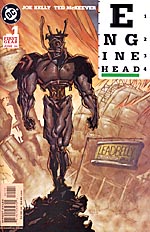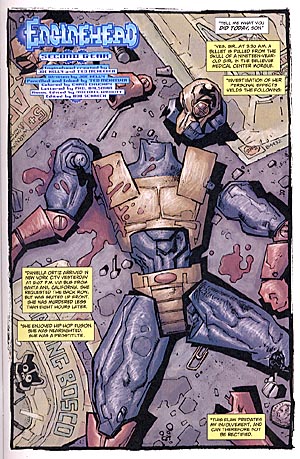 Written by Joe Kelly
Written by Joe Kelly
Art by Ted McKeever
32 pages, color
Published by Vertigo/DC Comics
I’ll be the first to admit that I love Ted McKeever’s art. I’ve got a bit of a blind spot to it, making me pick up books I might never have glanced at otherwise. And yes, that means it’s time to tell the truth: there’s no other reason that I would have read Enginehead #1-2. What I found, though, that’s another story entirely.
Take six beings and merge them into a single being, a synthesis of man and machine, and you’ve got Enginehead. That’s what the Mechanic and Grease Monkey were trying to do, taking people with mechanical skills and robots for part of their grand experiment. When one of the subjects chickens out at the last second, though, a substitution is made… so is that why the final creation, something able to see how the universe holds itself together, seems to be malfunctioning?
I’m of two minds on how Joe Kelly started Enginehead. On the one hand, I really appreciated that we didn’t spend half a dozen issues drawing together all the characters that make up Enginehead, instead jumping right into getting their replacement component and the creation of Enginehead itself. On the other hand, I almost wish we’d skipped that part entirely. Reading the second issue by itself just really made it clear to me that the first issue is still too much prelude and, at least for now, totally unnecessary. Kelly’s already having the Enginehead creation have flashbacks to its components’s previous lives, so why not use that by way of introduction? Instead it’s a slow introduction to the series (although I’m thankful it wasn’t even slower) that runs the risk of keeping readers coming back for more. As for the story itself, it’s got a lot of potential. The idea of someone able to see how events will play out in the future is a familiar one, but I like the execution of it being the world as a gigantic mechanical engine, with everyone being pistons in the workings. If Kelly keeps the book focused, this could be a real triumph, but it’s so early I’m still feeling a little hesitant on giving the series as a whole a yay or nay.
 McKeever’s art both does and doesn’t work for Enginehead. When it comes to drawing characters from other comics in the first issue, I must admit I was a little lost. (It wasn’t until after I read Enginehead #1 a couple of times that I suddenly realized that there was at least one character that I should’ve recognized from reading other stories with him.) At a glance, Ford and the Mechanic are a little hard to distinguish, save for hair styles. When it comes to the art in the second issue, though, it made me think that McKeever was indeed the right choice for Enginehead. Seeing the double-page spread of the world as a machine is fantastic, and McKeever’s way of drawing the worlds of flesh and metal combined into one is disturbing and intriguing at the same time. Seeing Enginehead crumble the massive truck to save a child, and then have the child’s future life flash before its eyes is a great sequence and that’s the sort of thing I want to see more.
McKeever’s art both does and doesn’t work for Enginehead. When it comes to drawing characters from other comics in the first issue, I must admit I was a little lost. (It wasn’t until after I read Enginehead #1 a couple of times that I suddenly realized that there was at least one character that I should’ve recognized from reading other stories with him.) At a glance, Ford and the Mechanic are a little hard to distinguish, save for hair styles. When it comes to the art in the second issue, though, it made me think that McKeever was indeed the right choice for Enginehead. Seeing the double-page spread of the world as a machine is fantastic, and McKeever’s way of drawing the worlds of flesh and metal combined into one is disturbing and intriguing at the same time. Seeing Enginehead crumble the massive truck to save a child, and then have the child’s future life flash before its eyes is a great sequence and that’s the sort of thing I want to see more.
Enginehead is an odd book. It’s not going to appeal to a lot of people, I think, thanks in part to McKeever’s decidedly offbeat and twisted art. It’s an acquired taste, but I love it. Hopefully future issues will be more like the second one and less like the first; now that the setup is done, Kelly and McKeever will hopefully get to the heart of the story.
